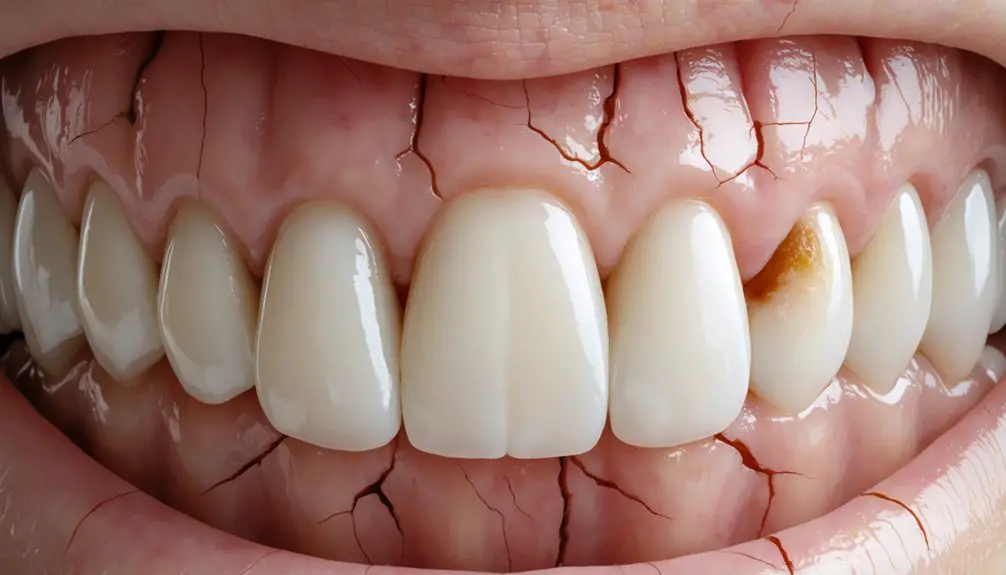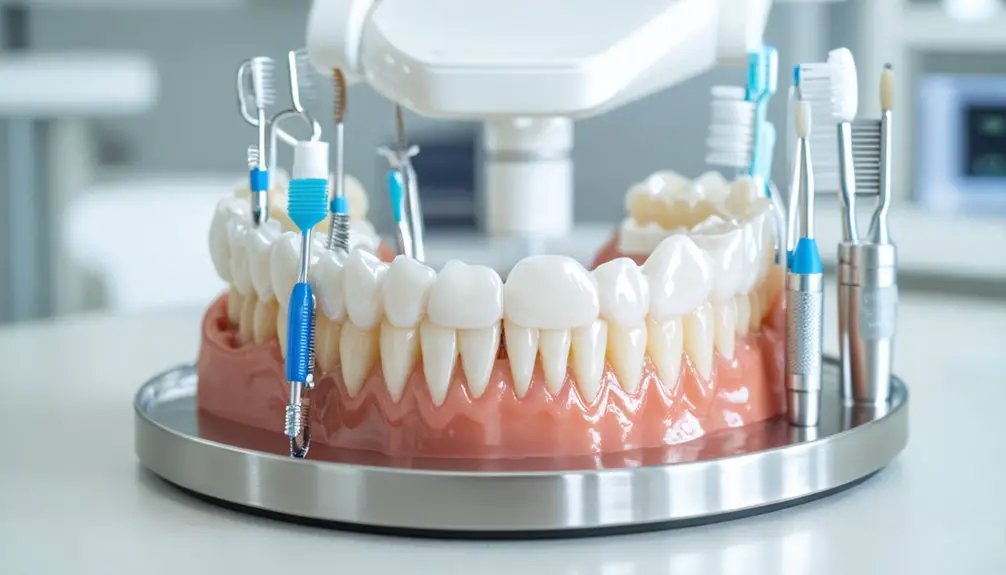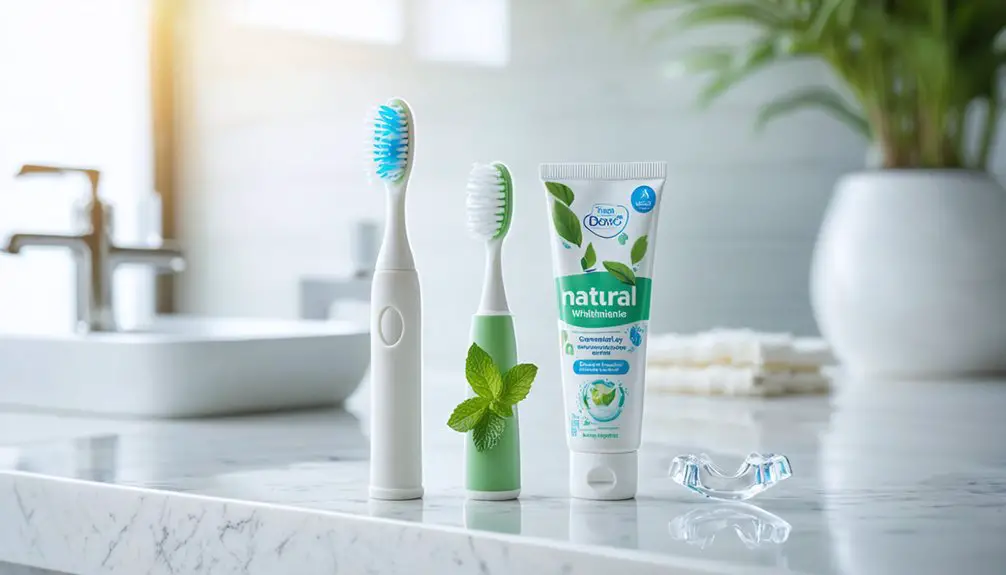If you have dental issues, teeth whitening can pose significant risks. Pre-existing conditions like tooth decay, gum disease, or dental work may lead to increased sensitivity, uneven results, or complications. You’ll need a dental evaluation before proceeding, as untreated cavities and periodontal problems can worsen with whitening agents. While temporary sensitivity affects up to 85% of patients, proper preparation and professional guidance will help minimize these risks and guarantee safer treatment outcomes.
Key Takeaways
- Untreated cavities and gum disease increase risks of adverse effects during whitening treatments, requiring dental evaluation before starting.
- Existing dental work won’t whiten with treatment, creating noticeable color mismatches between natural teeth and restorations.
- Pre-existing tooth sensitivity may worsen with whitening agents, especially when using higher peroxide concentrations.
- Exposed dentin and weakened enamel can lead to heightened tooth sensitivity and potential nerve irritation during whitening.
- Gum disease affects 68% of seniors and can cause increased sensitivity and inflammation when exposed to whitening agents.
Understanding Pre-Existing Dental Conditions
Before considering any teeth whitening treatment, it’s vital to understand how pre-existing dental conditions can affect your outcomes and safety.
Pre-existing conditions like tooth decay affect 90% of adults, while gum disease impacts 68% of seniors. These conditions can greatly complicate whitening procedures and increase your risk of adverse effects.
Untreated dental conditions are widespread and can make teeth whitening risky – address these issues first for optimal results.
A thorough dental evaluation is important because untreated cavities, exposed dentin, and periodontal disease make your teeth more vulnerable to whitening agents.
You’ll need to address these issues first, as bleaching chemicals can worsen inflammation, increase sensitivity, and potentially damage compromised enamel.
Additionally, existing dental work like crowns and fillings won’t respond to whitening treatments, which could result in uneven coloration.
Understanding these limitations helps guarantee you make informed decisions about your dental care.
Common Side Effects of Teeth Whitening
You’ll likely experience temporary tooth sensitivity and gum discomfort as the most common side effects of teeth whitening treatments, with sensitivity affecting up to 60% of patients.
Your sensitivity may peak immediately after treatment but typically resolves within 24 hours to two weeks, while gum irritation can persist for several days following exposure to bleaching agents.
Overuse of whitening products can lead to permanent enamel damage if not used according to professional guidelines.
You can minimize these effects by following professional guidance, using custom-fitted trays when applicable, and avoiding excessive product application or prolonged treatment times.
Using desensitizing gel treatments recommended by your dentist can help manage discomfort and make the whitening process more comfortable.
Tooth Sensitivity After Treatment
While teeth whitening effectively brightens your smile, tooth sensitivity remains the most common side effect, affecting between 30% to 85% of patients depending on the treatment method.
The sensitivity duration typically lasts 1-14 days, with most cases resolving within 24 hours after treatment.
Higher peroxide concentrations, particularly those used in professional treatments (35-40%), create stronger whitening effects but increase sensitivity risk. Dentin exposure during whitening treatments directly contributes to nerve sensitivity and discomfort.
You’ll experience temporary changes in your enamel’s permeability, which exposes the underlying nerve endings to temperature and pressure stimuli.
Most patients report mild to moderate discomfort, describing sharp, transient pain triggered by hot, cold, or sweet substances.
The good news is that sensitivity is reversible as minerals naturally re-deposit in your enamel post-treatment, restoring protection to the affected areas.
Studies show approximately 13.8% discontinue treatment due to sensitivity concerns, highlighting the importance of choosing appropriate whitening concentrations.
Temporary Gum Discomfort Issues
Along with tooth sensitivity, temporary gum discomfort ranks among the most frequent side effects of teeth whitening treatments.
When whitening agents like hydrogen peroxide contact your gums, they can cause chemical burns similar to sunburns, resulting in redness, tenderness, and white patches. You’ll likely notice stinging sensations and mild inflammation where the gel touched your gum tissue. Using a custom-fit tray during whitening helps prevent product from seeping onto gum tissue.
While these symptoms may feel concerning, gum healing typically occurs within 24-48 hours without lasting damage. Salt water rinses can help soothe irritated gum tissue during the healing process.
To minimize irritation relief time, guarantee proper application techniques and use protective barriers during treatment. If you’re prone to gum sensitivity or recession, opt for lower peroxide concentrations and professional application.
Should you experience persistent discomfort beyond a few days, consult your dental professional to evaluate potential complications.
Managing Whitening Side Effects
Managing whitening side effects requires a strategic approach to minimize discomfort while maximizing treatment effectiveness.
For ideal sensitivity management, you’ll want to start with lower peroxide concentrations, such as 10% carbamide peroxide, rather than jumping straight to higher-strength treatments. If you’re experiencing sensitivity, immediately discontinue use until symptoms subside. Research shows that tooth sensitivity occurs in 55% of patients using 10% carbamide peroxide over a two-week period.
Treatment adjustments play an essential role in preventing complications. Avoid using abrasive toothpastes during whitening procedures, as they can increase enamel wear. Over-the-counter products have become increasingly popular due to their convenience and lower cost.
Professional oversight is crucial for monitoring your progress and adjusting treatment protocols when needed. For best results, follow recommended application times strictly – overuse won’t enhance whitening but will increase adverse effects.
If you notice severe sensitivity or tissue irritation, consult your dental professional for personalized modifications to your whitening regimen.
Safety Considerations for Sensitive Teeth
Because tooth sensitivity can greatly impact whitening treatment outcomes, understanding proper safety measures is vital for patients with sensitive teeth. Teeth whitening agents containing peroxide compounds penetrate enamel layers to remove stains. A thorough sensitivity evaluation and enamel assessment by your dental professional should precede any whitening treatment. Professional consultation is especially important since dentists can properly diagnose underlying issues contributing to sensitivity.
If you’re prone to sensitivity, opt for products specifically formulated with lower peroxide concentrations and shorter application times.
You’ll need to be vigilant about following proper application techniques, using custom-fitted trays to minimize gum contact, and avoiding overuse of whitening products.
It’s important to use fluoride-containing products to help remineralize enamel and apply desensitizing agents when needed. If you experience severe or persistent sensitivity, don’t continue treatment without consulting your dentist.
Remember that conservative approaches and professional monitoring will help guarantee safe, comfortable whitening results.
Impact on Dental Restorations and Repairs

When considering teeth whitening, it’s important to understand how the treatment affects existing dental work. Whitening agents won’t lighten crowns, fillings, or veneers, which can create noticeable color mismatches with your natural teeth.
You’ll need to evaluate restoration compatibility before proceeding, as some materials are more susceptible to surface changes than others.
Proper whitening timing is vital. The peroxide in whitening products can weaken bond strength and interfere with new restorations, so you’ll need to wait after treatment before having dental work done.
Additionally, existing repairs may require more frequent maintenance, as whitening can affect their durability. Your restorations might need replacement post-whitening to match your new tooth shade and guarantee the best appearance.
Professional Vs At-Home Whitening Risks
The choice between professional and at-home teeth whitening presents distinct risk profiles due to significant differences in peroxide concentrations and application methods.
Professional supervision guarantees controlled application of higher-concentration peroxide (25-40%), with protective measures to minimize enamel damage and gum irritation.
While at-home risks include potential misuse of lower-concentration products (3-10%), the lack of professional oversight can lead to prolonged exposure and complications.
You’ll experience more intense but shorter-lasting sensitivity with professional treatments, whereas improper at-home use may cause persistent discomfort.
Without professional guidance, you’re more vulnerable to enamel erosion from acidic ingredients and improper application techniques.
Additionally, you won’t receive the benefit of pre-treatment assessment to identify contraindications or customized trays that provide the best protection of your oral tissues.
Prevention and Protection Strategies

To protect your teeth during whitening, select products with the ADA Seal of Acceptance and consult your dentist to verify their safety for your specific oral health conditions.
You’ll need to follow application instructions precisely, using custom-fitted trays when possible to minimize gum exposure and guarantee even distribution of the whitening agent.
It’s crucial to maintain proper timing and concentration levels of bleaching products, as exceeding recommended limits can lead to enamel damage and heightened sensitivity.
Safe Whitening Product Selection
Selecting safe and effective whitening products requires careful consideration of certifications, active ingredients, and application methods. Look for the ADA Seal of Acceptance as your primary indicator of product safety and efficacy.
When evaluating ingredients, focus on products containing 10% carbamide peroxide for home use or up to 35% hydrogen peroxide for professional applications.
During your product certifications review, prioritize dentist-dispensed options or ADA-approved over-the-counter alternatives like toothpastes, gels, and strips.
Your ingredient evaluation should emphasize formulations designed for sensitive teeth and avoid excessive chemical concentrations. For ideal safety, choose custom-fitted trays over standard mouthpieces, and consider professional treatments for the most controlled application.
If you’re using OTC products, select those with documented clinical testing and clear usage instructions.
Protective Treatment Application Steps
Proper protective measures during teeth whitening considerably reduce risks while maximizing results.
You’ll need to start with a thorough oral exam to identify any existing conditions that could affect treatment outcomes. Before applying whitening agents, verify you’ve placed protective gels and treatment barriers correctly to shield soft tissues from chemical exposure.
Always use ADA-approved concentrations and follow strict application protocols – 10% carbamide peroxide for at-home use and 35% hydrogen peroxide for in-office treatments.
Monitor tray fit continuously and adjust if needed to prevent gel leakage. If patients experience sensitivity, reduce peroxide concentrations in subsequent treatments.
Post-treatment, advise avoiding staining substances for a week and recommend desensitizing products. Schedule regular follow-ups to assess results and address any concerns promptly.
Managing Whitening Complications
While teeth whitening procedures are generally safe, complications can arise that require proper management and attention.
Complication identification often includes tooth sensitivity, gum irritation, uneven whitening, and possible systemic effects like stomach upset. If you’re experiencing sensitivity, try using desensitizing toothpaste, fluoride mouthwash, or over-the-counter pain relievers for symptom management.
For gum irritation, you’ll want to rinse with salt water and apply topical numbing gels. If you notice uneven whitening, particularly around dental restorations, consult your dentist for professional guidance.
To prevent complications, use custom-fitted trays, follow product instructions carefully, and maintain excellent oral hygiene. If symptoms persist or worsen, don’t hesitate to seek professional dental care for proper assessment and treatment.
Frequently Asked Questions
How Long Should I Wait Between Whitening Treatments to Avoid Permanent Damage?
You’ll need to wait 6-12 months between professional whitening treatments and 2-4 weeks between at-home sessions. Treatment intervals vary based on whitening frequency and product concentration.
Can Certain Medications Affect the Safety or Effectiveness of Teeth Whitening?
Yes, medications can markedly impact whitening efficacy and safety. You’ll need to be cautious if you’re taking antibiotics, antidepressants, or blood pressure medications, as they can affect treatment results and sensitivity.
Are Natural Whitening Methods Like Charcoal and Baking Soda Safer Alternatives?
Despite higher abrasiveness scores than baking soda, charcoal’s efficacy remains unproven. You’ll find baking soda safety superior, but neither option matches professionally-supervised whitening treatments. Both risk enamel damage with prolonged use.
Does Age Play a Role in Tooth Sensitivity During Whitening Procedures?
Yes, age factors greatly influence your sensitivity levels during whitening. You’ll likely experience more discomfort if you’re older due to natural enamel thinning and gum recession that comes with aging.
Can Previous Root Canal Treatments Impact the Whitening Process Negatively?
While your teeth may feel like stone fortresses, root canal effects can greatly limit whitening expectations since the treated tooth lacks internal blood supply and may resist external bleaching treatments.
References
- https://narrewarrendentalcare.com.au/risks-of-teeth-whitening-what-you-need-to-know-before-getting-started/
- https://www.dentistryofwestbend.com/teeth-whitening-risks-and-side-effects/
- https://pmc.ncbi.nlm.nih.gov/articles/PMC4058574/
- https://harborcreekdental.com/side-effects-of-teeth-whitening/
- https://www.alondradental.com/does-teeth-whitening-have-side-effects/
- https://www.cdc.gov/nchs/fastats/dental.htm
- https://www.ncbi.nlm.nih.gov/books/NBK576536/
- https://www.cdc.gov/oral-health/health-equity/index.html
- https://www.ada.org/-/media/project/ada-organization/ada/ada-org/files/resources/research/dqa/educational-resources/measuring_oral_healthcare_quality_in_older_adults_report.pdf
- https://pmc.ncbi.nlm.nih.gov/articles/PMC2821841/



